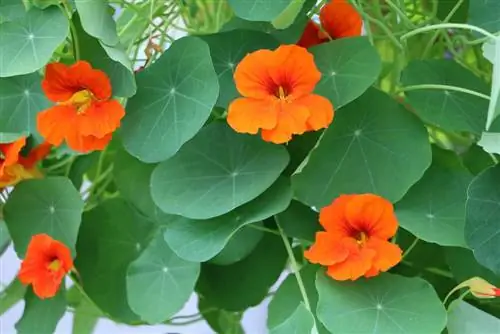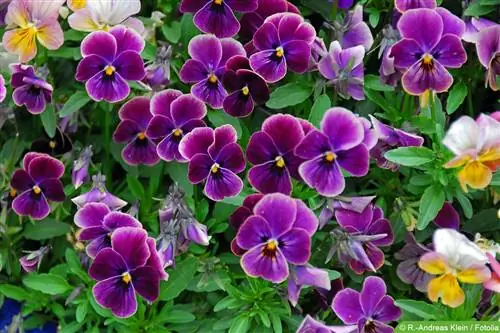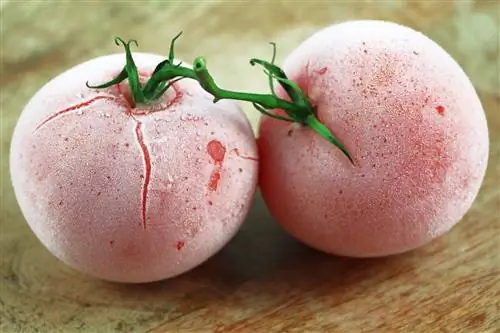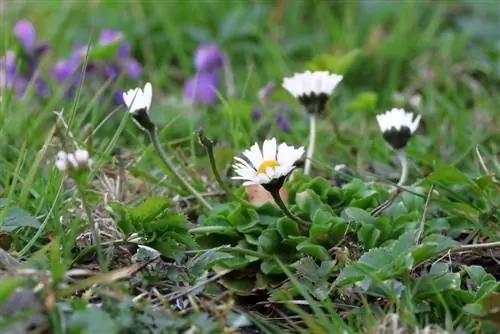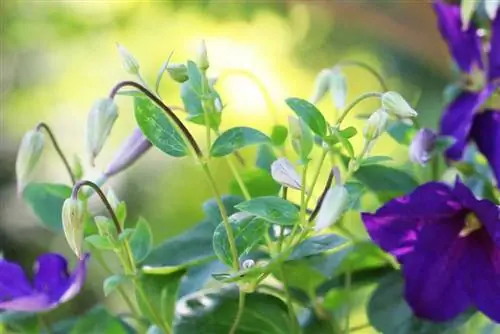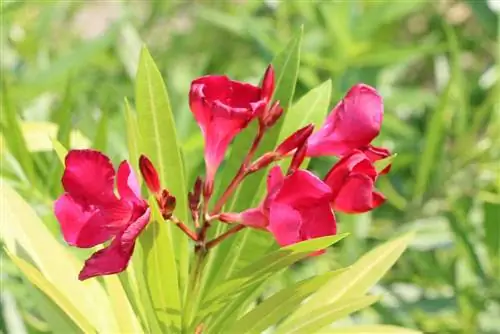- Author admin [email protected].
- Public 2023-12-17 03:39.
- Last modified 2025-01-24 12:45.
Enjoy the summer sun in a deckchair or have breakfast outdoors with your partner on Sunday: a balcony can be used and designed in many different ways. With the right plants, you can transform the front porch into a lush green landscape. The most important requirement for finding suitable plants for the balcony: The plants must be suitable for cultivation in smaller and larger pots. With the right tips you can find insensitive plants that tolerate sun and rain equally.
The right planting
Which varieties are suitable for your balcony depends on various factors. In addition to the size of the possible storage space, the location also plays an important role. For example, many plants cannot cope with dark places. However, a balcony on the south wall of the house can also have a negative effect on the development of various plants. To keep an overview, it makes sense to create a rough sketch. The following questions should be clarified before planting the balcony for the first time:
- How much sun or shade is there?
- How much space is available for the plants?
- Where and to what extent can flower pots be installed?
There may be requirements for pots that are attached directly to the railing. It is not uncommon for the rental agreement to stipulate a uniform design of the house facade. Even if you have to comply with the shape, color and size, you can still create a green oasis of well-being on your balcony with insensitive plants. With the right planning, it is possible to use the balcony in a variety of ways. For example, use weatherproof chests to neatly store garden tools.
Tip:
Collect excess irrigation and rain water to avoid unnecessary arguments with the neighbors.
Effective and space-saving
Passionate plant lovers know: In order to provide yourself with fruit and vegetables on a small scale, you don't necessarily need a large garden. Urban gardening is the name of the trend that is actively practiced in many small and large cities. Every available centimeter on roof terraces and balconies is used to plant edible plants. The advantage: Many types of vegetables grow easily in the balcony box and the house wall can also be converted into a vertical garden.
A small selection of fruit and vegetable plants that tolerate rain and sun:
Carrots
A tall pot is enough to grow the orange root vegetables on the balcony. Sowing the annual Daucus carota subsp. sativus occurs between March and June.
Nasturtium
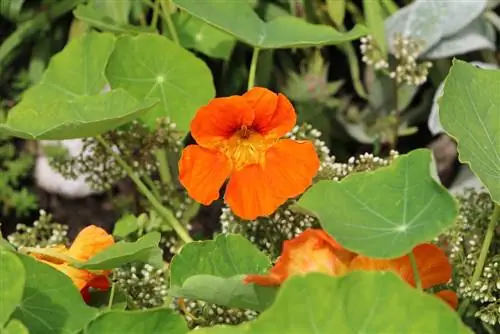
Tropaeolum majus is a frost-sensitive plant that, with its long stems and large flowers, serves as a decorative privacy screen on the balcony. With the exception of the roots, all parts of the perennial are edible. The cruciferous plant needs a lot of water and has no objection to a location in full sun.
Peas
Pisum sativum has become an integral part of many kitchen gardens. A lot of rain and sun does not bother the pea. The heavily branched root system needs a stable and large container. The long shoots can be tied to trellises to save space.
Peppers
The nightshade family is a perennial plant, but it can be harvested in the first year of life. Various Capiscum species are available for cultivation in buckets.
Easy-care balcony plants
To enjoy a lush balcony, you don't necessarily have to be a professional or even have specialist knowledge. All that is needed is time and a little effort so that the small plants become beautiful and resilient plants within a few weeks. Finding the right varieties that are uncomplicated and can withstand rain and sun is not difficult.
Perlargoniums
Geraniums are among the classic balcony plants. The cranesbill family is represented by up to 280 species worldwide. The vegetative characteristics of the different varieties vary greatly. A sunny and warm place on the balcony is preferred. Under optimal conditions, the ornamental plants produce their lush and long-lasting flowers. Geraniums can be grown in balcony boxes, but they take up a lot of space. The robust perennials have no objection to rain, as long as there is no waterlogging.
horn violets
Viola cornuta has been adorning domestic flower boxes for many decades. Many hybrids of the colorful mini violets are hardy and can easily survive double-digit temperatures in the pot. The perennials belong to the violet family and can be combined variably with other types of perennials.
Fuchsias
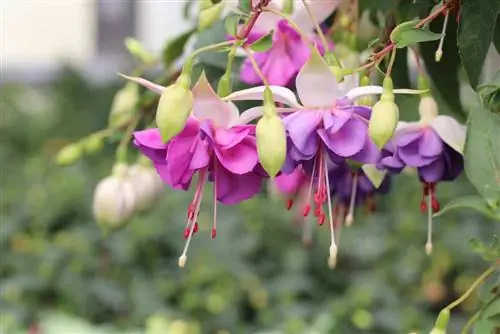
Rainy weather doesn't bother the species-rich Fuchsia x Hybrida much. Most varieties of the evening primrose family are annuals and reach a height and width of up to 50 cm. Just like the growth habit, the flower color also varies. Everything from white to dark purple is represented.
Gerbera
Some hybrid forms of the popular daisy family are insensitive to cold. Warmth and plenty of water are necessary for cultivating the herbaceous plant. However, standing water in the planter or saucer can also cause root rot in the Gebera.
Hardworking Lieschen
Impatiens walleriana is one of the classic balcony plants for many people. Properly staged and combined with other plants, the perennial is by no means a thing of the past. Whether shady or sunny, the location plays no relevant role in the cultivation of the busy Lieschen. The substrate should not dry out, otherwise the herbaceous plant can be left to its own devices in summer.
Dwarf Zinnias
Bright colors and semi-double, dahlia-like flowers are the trademark of the plants that come from Central America. Different varieties of Zinnia have adorned local cottage gardens and natural park landscapes for centuries. The upright growing structural plant prefers a sunny spot and blooms all summer long.
Jewelry basket
The two-tone flowers of Cosmos bipinnatus are an enrichment for the balcony. The colorful cosmos come from Central America and can reach flowers up to 7 cm in diameter. Rain can cause little damage to annual perennials as long as the plant's roots are not unnecessarily exposed to waterlogging. Recommended varieties include “Capriola”, “Fizzy Dark Pink” and “Velouette”.
Strawflowers
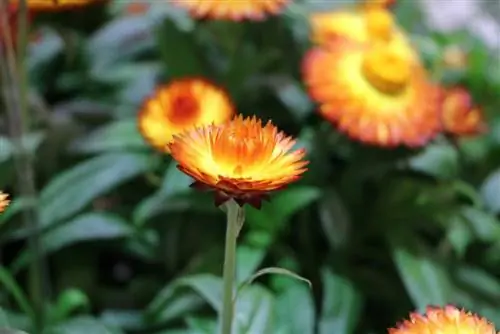
The strange-sounding term does not hide decorative flowers made from hay, but rather colorful plants from the daisy family. The name of the perennial, which grows up to sixty centimeters high, comes from its stiff, straw-like petals. Helichrysum bracteatum is cultivated as an annual and is considered robust and insensitive, even when kept on the balcony. Varieties such as “Nevada Rose”, “Nanum” and “Dazette Elektra” were bred specifically for cultivation and care in pots.
Tip:
Flower boxes with a storage tank and a water level indicator have proven successful for balcony plants. Hydroponics can also be used for ornamental plants.
Insensitive grasses
With their delicate stalks and flower spikes gently swaying in the wind, ornamental grasses are a feast for the eyes. Pampas grass and the like not only feel at home in beds, but also make attractive container plants. There should be suitable space for development. When placed correctly, the larger specimens can serve as decorative privacy screens. All ornamental grasses only come into their own on the balcony and terrace as solitary plants. Decoratively cover dull house walls with the larger species or shield the balcony from the eyes of curious neighbors with the long leaves and tall flower spikes.
Pennisetum grass
Pennisetum alopecuroides is a lush-growing plant from the sweet grass family. The bristle-like, colorful inflorescences gave the plant the additional name “feather bristle grass”. Growth heights of over 150 cm are not uncommon for some varieties of Pennisetum. Smaller species are suitable for the balcony, such as the 30 cm high sweet grass variety “Little Bunny”. Sun and rain are important factors that the hardy Pennisetum grass needs to grow.
Pampas grass
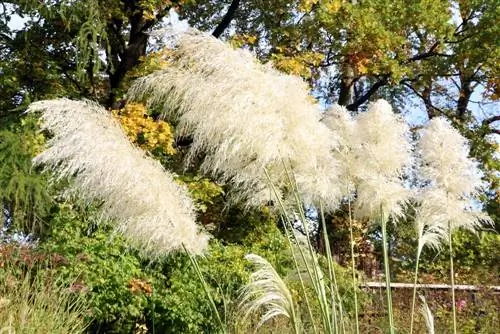
Cortaderia selloana is a striking representative of the ornamental grasses with its large, white flower spikes. The inflorescences of the plant, which originally comes from South America and New Zealand, can reach a height of up to 2.50 m. With a little effort, the ornamental grasses can survive ice and frost outdoors undamaged.
Sedges
Carex are evergreen ornamental grasses whose leaves have a striking feature: the long stalks have a triangular cross-section and are filled with pith. The color spectrum ranges from various shades of green to green and white variegated leaves to red, brown and bronze tints. The sour grass family loves a location in full sun, but needs special protection in winter.
Blue-ray meadow oats
Helictotrichon sempervirens originally comes from alpine regions and can cope with the local weather without any problems. The plant with the rigid clump of leaves can reach a height of up to 1 m. Lime-rich, lean substrate promotes the resistance of the blue oats.
Bamboo
With 12 subfamilies and well over 116 different genera, this family of sweet grasses is one of the most species-rich representatives among the ornamental grasses. Many bamboo species are undemanding and are suitable for keeping in containers. Popular varieties include:
- Fargesia Rufa
- Fargesia robusta ‘Campell’
- Fargesia jiuzhaigou
- Phyllostachys aureosulcata ‘Spectabilis’
The evergreen and fast-growing plants are almost indestructible. The popular ornamental grasses can cope with even short-term drought.
climbing plants
Trailing plants beautify the balcony and harmonize with the rest of the plants in a rich contrast. The advantage of the plants: The perennials grow taller, so the available space can be used better and more cleverly. No climbing plant has anything against a supportive trellis in the form of bamboo sticks, wooden strips or stretched cords.
The following perennials can cope with sun and rain:
Balloon wine
Cardiospermum halicacabum is a fast-growing annual plant with balloon-like fruits. The attractive perennial climbs walls effortlessly with a sturdy trellis and also cuts a fine figure in hanging baskets. With good care, the balloon vine can reach a shoot length of up to 2.5 m.
Clematis
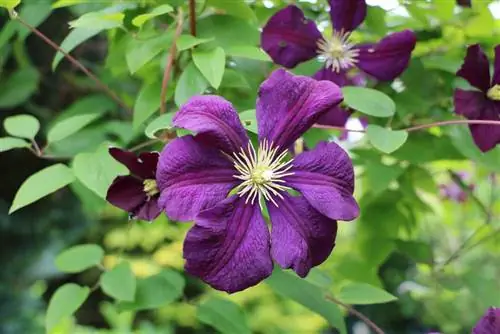
Clematis are among the most popular climbing plants. With their dense, fast growth, they effortlessly climb house facades and give pergolas in the garden a romantic atmosphere. Small species, such as Clematis alpina, are suitable for the balcony. The perennial is easily able to climb trellises with the help of its strong shoots.
creeper knotweed
With its trail-like, overhanging growth habit, Polygonum aubertii is a popular climbing plant. The knotweed is robust and does not impose any special conditions on either the location or the substrate. Strong pruning must be carried out regularly in the container to regulate the strong growth of the perennial.
Passionflower
Passiflora is a species-rich and globally distributed plant genus. The passionflower family impresses with its eye-catching, colorful flowers and tasty fruits. The climbing plant is sensitive to frost, but can cope with sun and rain equally in summer. With optimal care, a growth height of almost 3 m is not unusual.
Climbing roses
The queen of flowers is also happy with locations on the sunny balcony. Rosa lucieae is a semi-evergreen climbing rose that can produce shoots up to 5 m long. Climbing roses have strong growth, regular shaping and pruning is also necessary for potted plants.
Tip:
Ivy is a widespread climbing plant, but its roots can cause severe damage to house facades and wooden railings.
Autumn planting
When summer comes to an end and the plants show their most colorful side, the balcony season is far from over. With the right types of plants you can plant a variety of pots and pots for autumn.
Heather
Sun and rain cannot harm Erica carnea. The heather herbs for the balcony are evergreen dwarf shrubs that can bloom until late autumn. Erica carnea can be combined decoratively with other perennials.
peat myrtle
Wintergreen foliage and colorful, spherical berries are the characteristic features of Pernettya. The evergreen, low-growing shrub is a colorful eye-catcher on the autumn balcony. Choose a cultivated variety because its wild relatives can reach a circumference of over 1.5 m.
Purple Bells
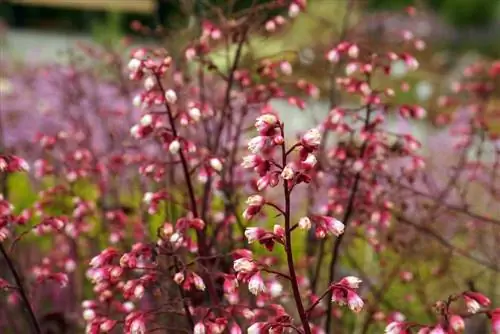
With its funnel-shaped bell flowers and attractively patterned leaves, the Heuchera doesn't have to hide behind other plants. Depending on the variety, purple bells can reach a height of between 15 and 70 cm.
Bergenia
With its evergreen foliage and colorful flowers, the decorative foliage perennial shows that winter doesn't have to be gray and bare. The saxifrage plant can be easily overwintered on the balcony and, if well cared for, produces rounded leaves that are up to 35 cm in size.
Conclusion
With the right plants, every balcony can be transformed into a green oasis where you can relax after a stressful everyday life. Many perennials from specialist retailers are suitable for cultivation in containers. Before buying, however, it is important to find out enough about the location requirements and space requirements of the respective plants. With the right planning, you can enjoy the splendor of plants on your balcony even in autumn.

